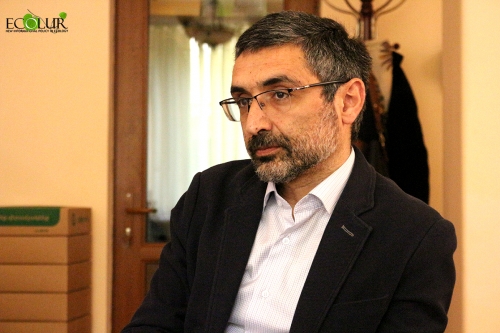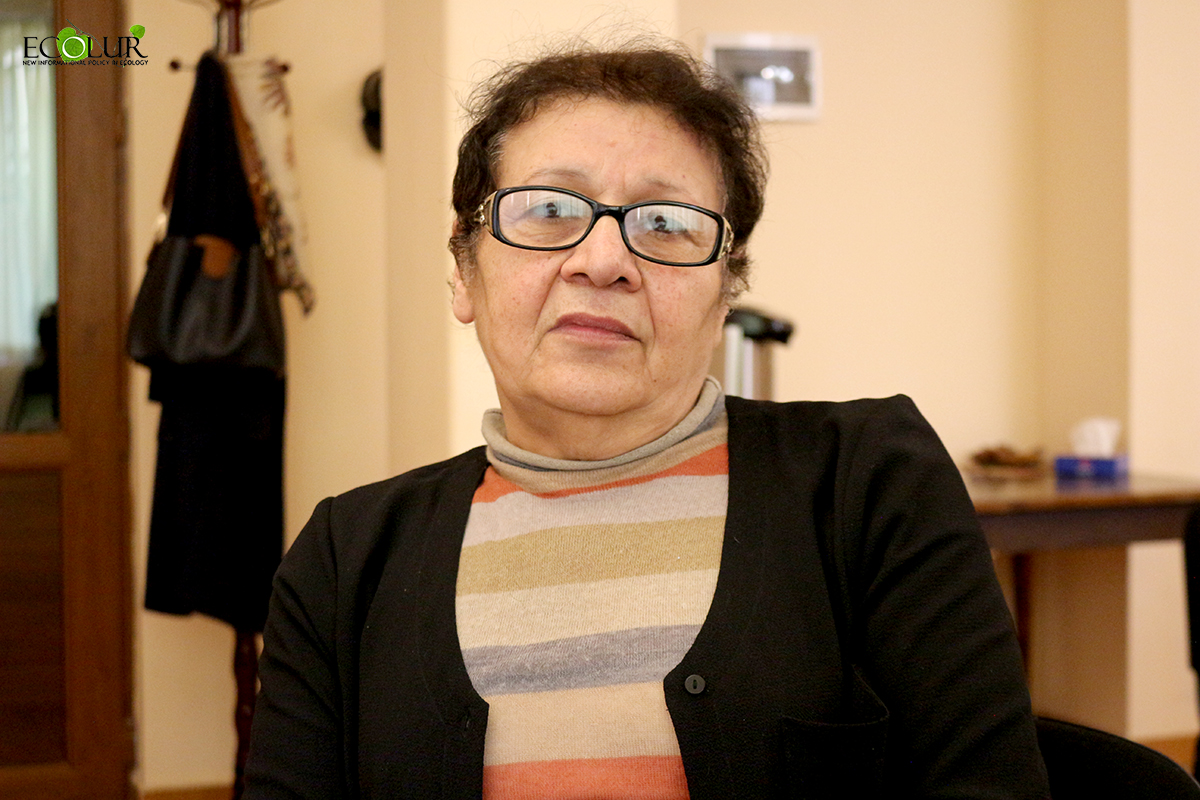

Is the vulnerability of water resources in Armenia to climate change assessed, what are the gaps in climate change adaptation planning and what are the recommendations to fill those gaps? Vahagn Tonoyan, National Advisor on Water Resources and Adaptation at UNDP/GEF, addressed these and other issues during the expert roundtable on "Water Resources Security in Armenia under the Climate Forecast Scenario" held on March 30 at EcoLur Press Club.
Welcoming the participants of the meeting, UNDP Climate Change Program Coordinator Diana Harutyunyan noted that the issues of vulnerability and adaptability of water resources are related to different areas, from water use to disaster forecasting and prevention.
"In the event of depletion of water resources and rising temperatures, we will have health problems related to the quality of water resources. The risks will be much more severe and pronounced. We present all these issues in the form of future risk forecasts, which should also guide the development of appropriate policies. Expert opinions are very important, they will give impetus to think in that direction, to develop appropriate policy decisions and regulatory mechanisms, both in terms of access to water resources and drainage, to improve sanitation and anti-epidemic services," she said.
In his speech, Vahagn Tonoyan noted that Armenia is considered a country with high initial water stress, which means that the ratio of usable water resources to water intake is considered risky. According to the World Resources Institute, Armenia ranks 34th among 164 UN member states in terms of water stress. According to the Organization for Economic Co-operation and Development, Armenia is a water-scarce country subject to water stress, with a water utilization index above 45%.
All water resources combined in Armenia are sufficient to supply about 3,100 m3 of water per capita annually, whereas the neighbouring countries, in Georgia, for example, the similar figure is 11,600 cubic meters, 3,800 cubic meters in Azerbaijan. Moreover, Armenia faces a severely disproportionate spatio-temporal distribution in terms of water resources. The speaker emphasized that Armenia lags behind the countries of the region in terms of the possibility of accumulating water per capita. "We are about 4.5 times behind Turkey and Azerbaijan, 60% - Georgia, only Iran is close to that index. There is significant work to be done in this regard. About 96% of drinking water, more than 40% of water intake is groundwater, and their proper management also plays an important role. The irrigation sector continues to be the largest consumer in Armenia. And in recent years, hydropower has been developing, with an annual water intake of more than 5 billion cubic meters. This development puts significant pressure on water resources in some river basins, particularly in terms of violating the environmental flow.
The above-mentioned problems are exacerbated by the fact that in recent years Turkey has started intensive construction of reservoirs for irrigation and conditioned with this fact, the average annual flow of the Araks transboundary river is expected to decrease by about 56%, which will have a significant impact on Armenia due to the 50% -50% proportion of the Araks River flow being used jointly with Turkey," Vahagn Tonoyan said.
According to forecasts, starting from 2040, a significant reduction in river flow will be observed in some river basins. The changes of the annual river flow until 2100 were analysed as compared to the baseline period of 1961-1990. According to the analysis, the expected percentage reduction in river basins ranges from 17-39%.
He noted that the volume of river inflow to Lake Sevan was also estimated. Until 2100 it will also be reduced compared to the baseline period (total river inflow in the baseline period is 758 million m3).
"The projected decrease in river inflow is in the range of 137-309 million cubic meters. The need to implement climate change adaptation measures must be substantiated in the near future," the speaker said.
According to Vahagn Tonoyan, there is no actual evaporation data for assessing the water balance of Lake Sevan. The same problem exists with reservoirs. Evaluation of evaporation is currently based on data from the Soviet years. We need more accurate data," he said.
Continuing the problems related to the reservoirs, the speaker mentioned, “We suggest to study once again the concept of reservoir development, which was developed by "Hayjrnakhagits" institute in 2014, to view it from the point of view of climate change, because the reduction of river inflow to the reservoirs has been observed, and it is predicted that it will happen again.
The main suggestion is that in the context of climate change, analysis should be carried out before conducting feasibility studies for reservoirs. "We need to review the concept of reservoirs to understand whether or not we will have sufficient water in those reservoirs, then to procced to detailed project designing," he said adding that 87 reservoirs with a total volume of 1.4 billion cubic meters were built during the Soviet era for the spatial and temporal distribution of water resources in Armenia.
Vahagn Tonoyan noted that within the framework of the National Climate Fund's National Adaptation Program, the National Adaptation Program is currently being developed for six priority areas, one of which is the water resources sector. "The goal of the program is fully in line with the goals of national security, sustainable development and the commitments undertaken by Armenia under the Paris Agreement. It is expected that we will have that project by September 2021," he said.
According to Vahagn Tonoyan, the gaps identified in the Adaptation Program relate to legislation, management and monitoring of programs implemented in sectoral areas. "The impact of climate change is not sufficiently reflected in the legislation. We provide long-term licenses in the field of hydropower. The climate change factor must be considered here. The field of water use should also include, consider the results of assessing the vulnerability of water resources to climate change, reflect them in the development of strategies and concepts in those areas, consider the impact of climate change," he said.
Vahagn Tonoyan mentioned that it is necessary to review the irrigation norms. The current irrigation standards were developed in 2007 based on data from the 1970s. "After that period, we have a rise in temperature, that is, a change in water demand.
It is necessary to introduce innovative water-saving, energy-efficient technologies, to reduce the losses of irrigation systems, as we have more than 40% of losses in the field of irrigation, that is, to take appropriate adaptation measures.
With regard to drinking water supply, it is also necessary to consider the quantitative and qualitative vulnerability of drinking water sources to climate change, as well as projected changes in water demand. To this end, we propose to introduce water-saving, energy-efficient technologies in water supply systems, reduce leakages, which amount to more than 70%.
Regarding hydropower, we propose to review "Strategic Program of RA Hydropower Sector" taking into account the vulnerability of water resources to climate change, as well as the new methodology of environmental flows, because we believe that there may not be enough water for a number of designed hydropower plants," the speaker said.
Touching upon the gaps in the data of hydrometeorological monitoring, Vahagn Tonoyan noted that in order to better assess the vulnerability, 14 new hydrological observatories should be established in the flow formation zones, where there is no anthropogenic impact.
"If we have such points in those zones, we can already assess the change in flow due to the impact of climate change due to change.
According to the speaker, there is also a problem due to insufficient data on actual water use. Armenia also has a problem assessing the impact of climate change on groundwater resources. "We have a reduction in groundwater vulnerability, but the extent to which it is affected by climate change is not assessed.
In this case, it is necessary to strengthen the quantitative monitoring of groundwater, to conduct research to assess the vulnerability of groundwater resources in Armenia. "It is necessary to strengthen the State Water Cadastre, to improve the existing data exchange system, so that in order to assess the vulnerability of water resources in the country, we have accurate, reliable and accessible data on hydrological-meteorological parameters of shared use," he said.
Inga Zarafyan, President of EcoLur Informational NGO, asked what the worst scenario for water resources might be, and what the rates of such deterioration would be given that the forecasts of the scenarios in the national climate change messages change from year to year. Tonoyan responded: “It depends on what scenarios we use, what is the regional model. One thing is clear, the temperature continues to rise. Only with that we can already say that the demand for water will increase, but there are many uncertainties and inaccuracies related to precipitation. The numbers are different in different national messages related to them. It is connected with inaccuracies and scenarios," Tonoyan explained.
Inga Zarafyan inquired what measures could be taken to avoid or reduce the temperature. In response, Vahagn Tonoyan responded that adaptation measures should be implemented in advance, combining institutional and legislative changes.
"All sectors must take climate change into account in their strategies. We can now do more through adaptation measures to alleviate the situation, including the use of economic and financial mechanisms to increase water efficiency. For example, currently used water and consumption meters do not encourage more economical use of water. As a resource payment, “Veolia Water “CJSC pays 25 lumas per cubic meter to buy water and sells it to the resident for 185 AMD," he said.
Expert Rosa Julhakyan inquired about their opinion on the issue of setting a fee for nature use for water used by hydropower plants. In response, Vahagn Tonoyan responded that the hydropower sector is considered a non-consumer water use, due to which there is no rent for water intake, but in 2014 the Organization for Economic Cooperation and Development conducted a study in Armenia, which considered the use of European countries' experience and the possibility to apply partial payment (up to 10% of current rates).
According to the calculations, the application of such an approach will not have a significant impact on the tariff for energy supplied to consumers, but, at the same time, will significantly increase the efficiency of water use and generate significant additional funding for the water sector (implementation of watershed management plan measures, improvement of the monitoring system etc).




April 16, 2021 at 15:24
